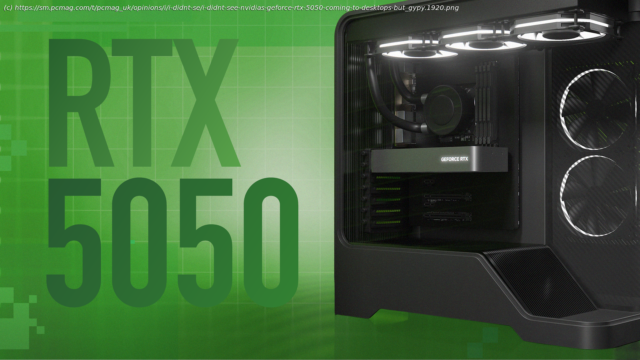The coming $249 RTX 5050 desktop cards might win on brand power alone, with the $299 RTX 5060 helping Nvidia lock up the budget GPU market—unless AMD and Intel take quick action.
Nvidia just stealth-dropped news of a GeForce RTX 5050 desktop graphics card coming in middle or late July. Color me surprised. I suppose that particular color should be Nvidia green. But I’m betting AMD’s and Intel’s graphics teams are red-faced about now.
To be sure, we saw hints of an upcoming GeForce RTX 5050, but we had reason to suspect it would be a mobile-only GPU, designed solely for laptops. Given that a desktop-card GeForce RTX 4050 never materialized in the last generation of Nvidia GPUs, we figured the « x050 » class would be skipping gaming desktops this time, too. Not so. The release of desktop RTX 5050 cards is imminent, and that’s poised to alter the balance of power in the market for budget graphics cards.
If AMD and Intel hope to fend off this new competitor from the 800-pound gorilla of graphics, they may have to change up their product lines—or their pricing—to maintain their respective shares of the budget market. Here’s why I think Nvidia’s rivals will want to respond quickly, or risk ceding ground in yet another desktop-GPU price bracket. I also have thoughts on why Nvidia’s more upscale chip, the recently released GeForce RTX 5060, only makes matters worse for them.Nvidia GeForce RTX 5050: The ‘Potentially Good Enough’ Card
Looking over the Nvidia GeForce RTX 5050’s specs, this graphics card appears somewhat lackluster. Sure, that’s expected from a budget product, but it’s arguably a bigger step down from Nvidia’s recently released GeForce RTX 5060 than you might expect. Across the board, the GeForce RTX 5050 ships with roughly 33% fewer resources than the RTX 5060.
Start by looking at shaders and memory. Along with the substantially reduced shader count, the GeForce RTX 5050 also has significantly less bandwidth than the RTX 5060. That’s because Nvidia is making use of GDDR6 memory in the RTX 5050 GPU, not GDDR7 like the rest of its latest (GeForce RTX 50 series) GPUs, probably due to cost. How much effect this will have on performance is hard to say—but I’m going to gamble that it won’t be a serious issue on the budget-oriented RTX 5050.
Nvidia used GDDR6 memory on its former budget card, the outgoing Nvidia GeForce RTX 4060, and that card used slower 17Gbps GDDR6, too. The Nvidia GeForce RTX 5050, in contrast, receives a hearty bandwidth boost, thanks to 20Gbps GDDR6. The RTX 5060 has a lot more bandwidth than the RTX 5050 (40% more!), but the RTX 5050 still has 18% more than the RTX 4060, which could be beneficial at higher resolutions. We’ll have to see in testing.
The GeForce RTX 5050 also has fewer shader resources than the RTX 4060, but the difference is much smaller than the delta between the RTX 5050 and the RTX 5060. Higher clock speeds and the increased bandwidth on the RTX 5050 could enable it to match, or even slightly surpass, the RTX 4060. But again, we’ll need to wait until we can test the RTX 5050 to know exactly how it stacks up.






